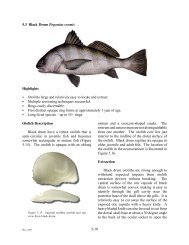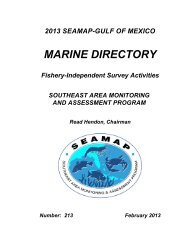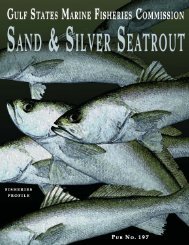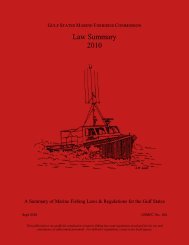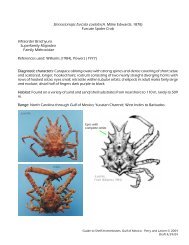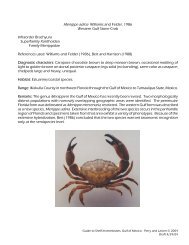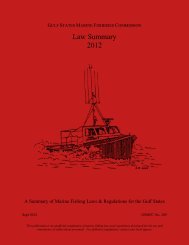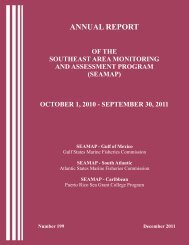Guidelines for Marine Artificial Reef Materials, Second Edition
Guidelines for Marine Artificial Reef Materials, Second Edition
Guidelines for Marine Artificial Reef Materials, Second Edition
Create successful ePaper yourself
Turn your PDF publications into a flip-book with our unique Google optimized e-Paper software.
condition, was $118,000 (Stan Blum, personal communication). Salvors involved complained to<br />
the Department of Defense about not being able to benefit from the more complete stripping of the<br />
vessel (Virginia Vail, personal communication).<br />
Today’s large military and civilian vessels have cleaning and preparation requirements which need<br />
to be evaluated in a cost-benefit analysis of their use as artificial reefs. Scrap steel values are low<br />
as of 2002. Additionally there is increased demand on the part of the diving industry to leave vessels<br />
externally intact in physical appearance to the extent possible. Estimates to cover all costs associated<br />
with hiring consultants, securing, permits, yard space, cleaning, hazardous waste removal and<br />
disposal, towing, sinking, <strong>for</strong> a military vessel over 500 feet long in 2002 range from 1-2.2 million<br />
dollars per vessel. For example the Spiegel Grove as only one component of its cleaning process had<br />
102 diesel, aviation fuel, lubricant, ballast, and sewage tanks which had to be individually cleaned,<br />
inspected and temporarily resealed. During the four months of cleaning, more than a dozen<br />
inspections by the U.S. Coast Guard <strong>Marine</strong> Safety Officer were required (Jason Walker, personal<br />
communication). The EPA mandated that all wiring from the Spiegel Grove be removed due to<br />
concerns about PCBs in the insulation. The wiring alone removed from the ship exceeded 100,000<br />
pounds, though the removal, temporary storage and shipment to a hazardous waste disposal site<br />
accounted <strong>for</strong> only about 4% of the overall vessel cleanup and preparation cost and precluded having<br />
to conduct an extensive amount of PCB sampling in a cable and wiring system thousands of yards<br />
long (Tim Mullane, personal communication). Even though an agency may receive a ship from the<br />
U.S. Maritime Administration <strong>for</strong> free, the subsequent individual ship cost estimates as projected<br />
in 2002 substantially exceed the annual operating budget of a typical state artificial reef program.<br />
Without major private, and local government financing and fund raising ef<strong>for</strong>ts as occurred with the<br />
Spiegel Grove, and Hoyt Vandenberg, or a federal plan to subsidize artificial reef deployments of<br />
federal ships, the expense involved in start-to-finish environmentally friendly cleanup and<br />
deployment of large military vessels remained prohibitively expensive <strong>for</strong> most state reef programs.<br />
As of 2001, the Navy and MARAD presided over a fleet of approximately 450 retired naval<br />
combatant and MARAD noncombatant ships. An estimated 358 of these ships will have to be<br />
disposed of by means other than donations as museums, in military sinking exercises (Sink-Ex), or<br />
overseas sales, or leases. These remaining inactive ships constituted a diverse range of vessel<br />
classes. They included merchant ships (145), auxiliary vessels (74), amphibious ships (31), surface<br />
combatants (71), mine warfare vessels (7), miscellaneous ships (19), submarines (3) and even<br />
aircraft carriers (8) (Hess et al. 2001). A cost analysis and feasibility study prepared <strong>for</strong> the Navy<br />
by the Rand Corporation (Hess et al. 2001) recommended disposal via “reefing” (sinking ships on<br />
artificial reef sites) off of U.S. coasts as a viable, but previously unexplored cost-effective alternative<br />
to subsidized shore-based stateside scrapping and recycling or long-term storage. Both the Navy and<br />
MARAD were interested in this approach and contracted with the Rand Corporation to determine<br />
what legislative and procedural initiatives needed to be identified to make this a viable option.<br />
By 2001, the Navy and MARAD recognized the impediments of making “as is, where is” vessel<br />
transfers to state artificial reef programs contingent upon no cost to the federal government. After<br />
Congress made the decision not to lift the moratorium on transfer of vessels overseas <strong>for</strong> scrapping<br />
purposes, in March 2003 MARAD announced to the coastal state artificial reef programs and the<br />
interstate marine fisheries commissions that it had been able to secure legislative authority in 2002<br />
to provide limited federal funding in the <strong>for</strong>m of grants to states to assist them with the cleaning,<br />
preparation, towing, and sinking of requested MARAD vessels <strong>for</strong> artificial reefs. 16 USC 1220c-<br />
-21-




